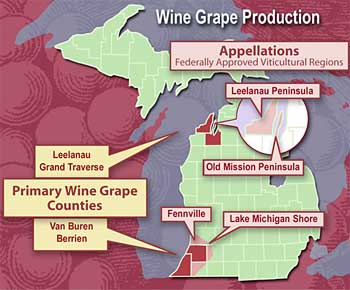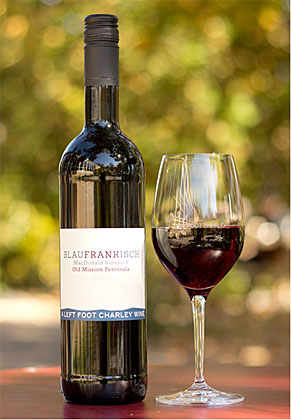| « Previous | News | Next » |
July 29, 2015
Blaufrankisch, Austria's spicy red rockstar-in Michigan?
 Michigan is deep in the throes of a winemaking frenzy, with the area under vine doubling in just the last ten years. Grapes have long played a part of Michigan’s produce; the state is a major supplier of Concord grapes to Welch’s Juice Company. But making wine from those grapes is a different story: winemaking has historically happened in fits and starts, and not until recently has it begun to achieve any real success.
Michigan is deep in the throes of a winemaking frenzy, with the area under vine doubling in just the last ten years. Grapes have long played a part of Michigan’s produce; the state is a major supplier of Concord grapes to Welch’s Juice Company. But making wine from those grapes is a different story: winemaking has historically happened in fits and starts, and not until recently has it begun to achieve any real success.
Winemaking in the state was first documented in 1679 when French explorers made wine from wild grapes growing along the Detroit River (Merci, the French!). These were not vitis vinifera, but native Concord, Niagara, and Catawba grapes, known to display foxy, unsavory aromas when fermented. According to a Michigan Wine Industry research report, a commander sent word back to France of “the wild vines heavy with grapes, of which the forest rangers say they made a wine that, considering its newness, was not at all bad.” “Not at all bad” is probably the best that could be said of these wines, and indeed of most of the wine produced up until the 1960s, when pioneer grape growers began to plant French-American hybrids. Warner Vineyards and St. Julian Wine Company were among the first, with many soon to follow. In 1969, Tabor Hill Winery planted the state’s first documented European vinifera varietals, Chardonnay and Riesling. From there, winemaking has taken off like gangbusters, with about 2,650 acres currently devoted to wine grapes, making Michigan fifth in wine grape production in the U.S. Cool-climate varietals and dessert wines tend to be the most successful.
It’s no surprise, then, that Blaufrankisch, Austria’s spicy red rockstar, is a real up-and-coming contender on the Michigan wine scene. Blaufrankisch is known for good color, tannin, and acidity. It has racy personality and the potential to age for a relatively long haul. Its home in Austria is very close in latitude to Traverse City (48.2000 N vs 44.7681 N), and climatically similar. Michigan’s unique “lake effect” can help protect vines with winter snow, which can slow down bud break for this notoriously early budder. The grape is very prone to spring frost, so a later bud break is an important layer of protection. The later budding also extends the growing season by up to four weeks.
 The Left Foot Charley Urban Winery in Traverse City makes a killer version with a touch of Pinot Gris from Old Mission Peninsula. Founder Bryan Ulbrich has teamed up with the Bill and Margaret MacDonald Vineyard to grow a half acre of this succulent grape in sandy loam soil. The 2013 is a pale purple-red in glass with a translucent magenta rim. It starts out very tight, but opens up with air to reveal baking spice, black raspberry, lavender-vanilla, mulberry, and black pepper. The palate continues on a note of berries: brambly, black raspberry and blackberry. The tannins are integrated and polished. This would be fantastic with a Greek smorgasbord: olive tapenade, feta cheese, hummus, pita, and baba ganoush.
The Left Foot Charley Urban Winery in Traverse City makes a killer version with a touch of Pinot Gris from Old Mission Peninsula. Founder Bryan Ulbrich has teamed up with the Bill and Margaret MacDonald Vineyard to grow a half acre of this succulent grape in sandy loam soil. The 2013 is a pale purple-red in glass with a translucent magenta rim. It starts out very tight, but opens up with air to reveal baking spice, black raspberry, lavender-vanilla, mulberry, and black pepper. The palate continues on a note of berries: brambly, black raspberry and blackberry. The tannins are integrated and polished. This would be fantastic with a Greek smorgasbord: olive tapenade, feta cheese, hummus, pita, and baba ganoush.
Unfortunately, Midwest winters can sometimes get the better of the grape (as they can get the better of all of us). The 2014 winter was not kind to the Left Foot Charley’s Blaufrankisch, so there won’t be another bottling until the 2016 vintage, which means it won’t be released until 2018. Fortunately, the 2013 is downright delicious, so stock up, get it while you can!
Written by Kate Soto
